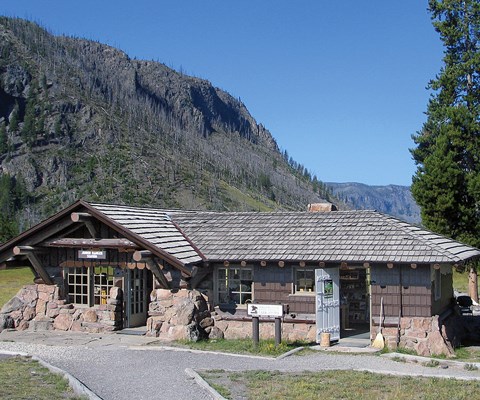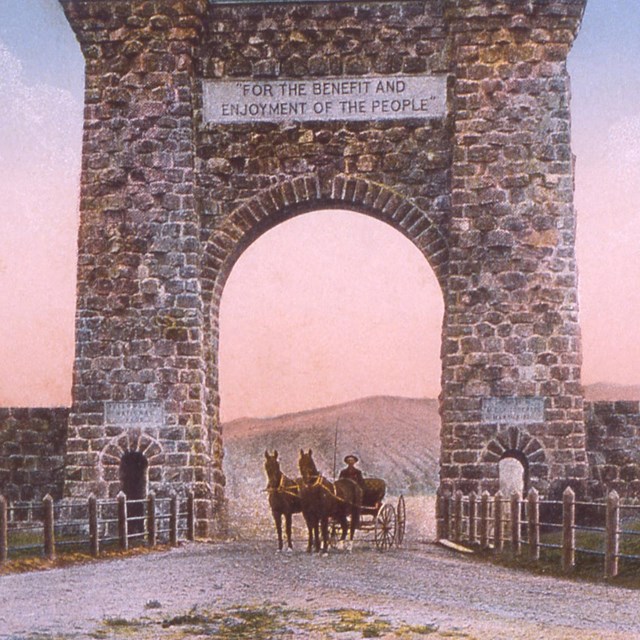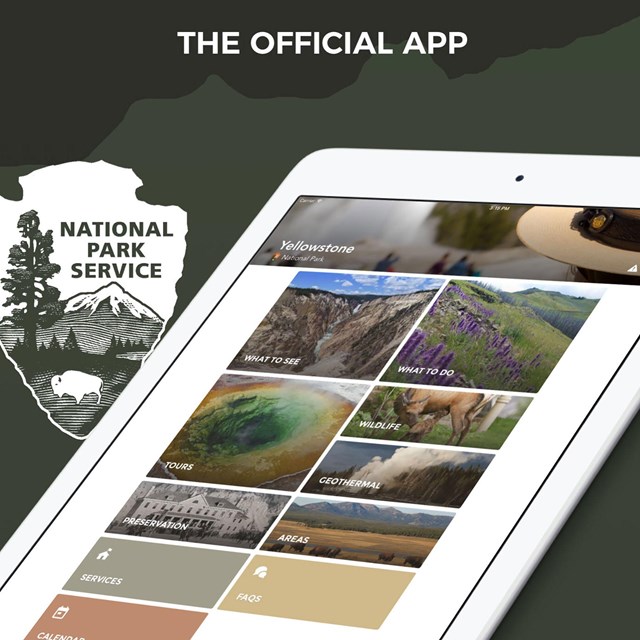|
The museums at Fishing Bridge, Madison Junction, and Norris Geyser Basin were designated National Historic Landmarks in 1987 because their exaggerated features and organic forms exemplify rustic design in the national parks and served as models for hundreds of park buildings constructed during work relief programs of the 1930s. As envisioned by the chairman of the American Association of Museums, Hermon Bumpus, they also established the idea of “trailside museums’’ where visitors could learn about an area within a park. Bumpus regarded national parks as “roofless museums of nature” with unlabeled exhibits and the trailside museum as the place to provide the labels. Designed by Herbert Maier in a style that became known as “Parkitecture,” the museums have the battered rubble masonry and clipped gables of a traditional bungalow style, but use locally available materials left in their natural condition to reflect the scale and roughness of the landscape. The asymmetrical boulders and gnarled logs display the irregularities of nature. Maier, who also designed museums for Grand Canyon and Yosemite, regarded buildings in national parks as “necessary evils” because even the best was “somewhat of an intruder.” Their National Register nomination described the trailside museums as “a perfect solution for an architecture appropriate to the outdoors: informal through the use of natural materials and horizontal lines,” but with “a strength of design and heavy-handed expressions” that “suggested the smallness of man in relation to nature.” History In 1928, Yellowstone Superintendent Horace Albright proposed the construction of “small local museums” to provide visitors with information that would “make their sojourn educationally as well as recreationally profitable.” With a grant from a foundation set up by John D. Rockefeller and the guidance of Dr. Bumpus, the American Association of Museums built four such museums in Yellowstone. The Museum of Thermal Activity, constructed at Old Faithful in 1929, was razed and replaced by a visitor center in 1971. It opened in 1929 to acclaim for its quality materials and construction, and for the way it blended into its surroundings. The exteriors of the other museums have changed little since their completion by 1932, but the interiors have undergone small and large alterations in design and use. In a 1942 report, park naturalist Bert Long pointed out that “due to lack of funds,” there were “many obvious gaps and inadequately told phases” of the Yellowstone story as told in its museums, and that many of the exhibits contained obsolete scientific theories. “Every attempt should be made to include in each museum information pointing out what there is to do of a recreational nature in its surroundings,” Long urged. “Get the people out of their cars, on the trails to the features and half the battle is more than won.” The difficulty of funding and keeping exhibits up to date has not lessened over the years, nor has the goal of getting people out of their cars changed, but the efforts to do so have. Only the Norris Geyser Basin Museum still has its original name. 
NPS Fishing Bridge Museum, 1931 Now called the Fishing Bridge Visitor Center, the building was designed so that visitors approaching from the parking lot could see through it to Yellowstone Lake, where stone steps lead down to the shore. In 1933, Superintendent Roger Toll complained that the irregular steps at the Norris and Fishing Bridge museums were “unsatisfactory for the considerable number of people that use these museums.” He asked the park’s landscape architect to “take advantage of this experience and not use any more native stone for the treads in park buildings.” Some of the stone steps at the Fishing Bridge Visitor Center have been replaced by rounded concrete steps and a ramp for accessibility. Antlers, rams’ horns, and bighorn sheep skulls still decorate the two wrought-iron chandeliers, but they were removed from the log frame around the screen in the adjacent amphitheater, where the original log seats were replaced with thick plank seats. No longer used, the fireplace beneath the large stone chimney is concealed from public view in a small area used for offices. During 2021–2022, linoleum tiles were removed to reveal the original scored concrete floor, and plywood covers were removed to reveal original windows that had been covered to accommodate shelving in the book sales area. The museum display cases (many designed and built by Dr. Carl Russell) were also rebuilt to accommodate shatter proof glass and reinstalled. 
NPS Norris Museum, 1929 The open foyer through the middle of the Norris Museum still functions as the visitor’s gateway to the Norris Geyser Basin. One of the two rooms on either side of the foyer originally contained bird specimens; both now have exhibits explaining geothermal activity and life in thermal areas. In 2020, the exhibits were updated, windows uncovered, and a removeable ramp was installed. Also designed by Maier with rustic architectural features, the nearby comfort station was converted to a Yellowstone Forever bookstore after a larger restroom of more contemporary style was built closer to the parking area. 
NPS Madison Museum, 1929 Overlooking a meadow beyond which the Gibbon and Firehole rivers join to form the Madison River, the Madison Museum was intended to focus on park history, especially the nearby site where the 1870 Washburn expedition was thought to have originated the idea of a national park as a way to protect the thermal areas from commercial development. In accordance with Bumpus’s vision of the museum’s “function as a national monument,” a large glass transparency created from a 1930 photograph was placed prominently in a window where the light shone through a re-enactment of the Washburn party gathered around a campfire. In 1940, a park naturalist suggested that the main room’s floor, made of large, uneven pieces of rhyolite, should be covered with oak or pine to “avoid possible hazards to visitors from stumbling falls” and make it easier to clean. That did not happen, but when the building was transformed into the “Explorers’ Museum” as part of Yellowstone’s 1972 centennial celebration, carpeting and track lighting were installed, the wood stove that used to heat the building was removed, and the exhibits were redesigned. In acknowledgement of evidence long put forth by historian Aubrey Haines that refuted the “campfire story,” the re-enactment transparency and references to the Washburn party’s role in establishing the first national park were removed from the museum. However, in deference to Albright, still influential in retirement, and National Park Service officials who would not abandon the story, the purported campfire discussion was commemorated in a sign placed outside the museum: “…there emerged an idea...that there should be no private ownership of these wonders but that the area should be preserved for public enjoyment.” More Information
|
Last updated: April 18, 2025



